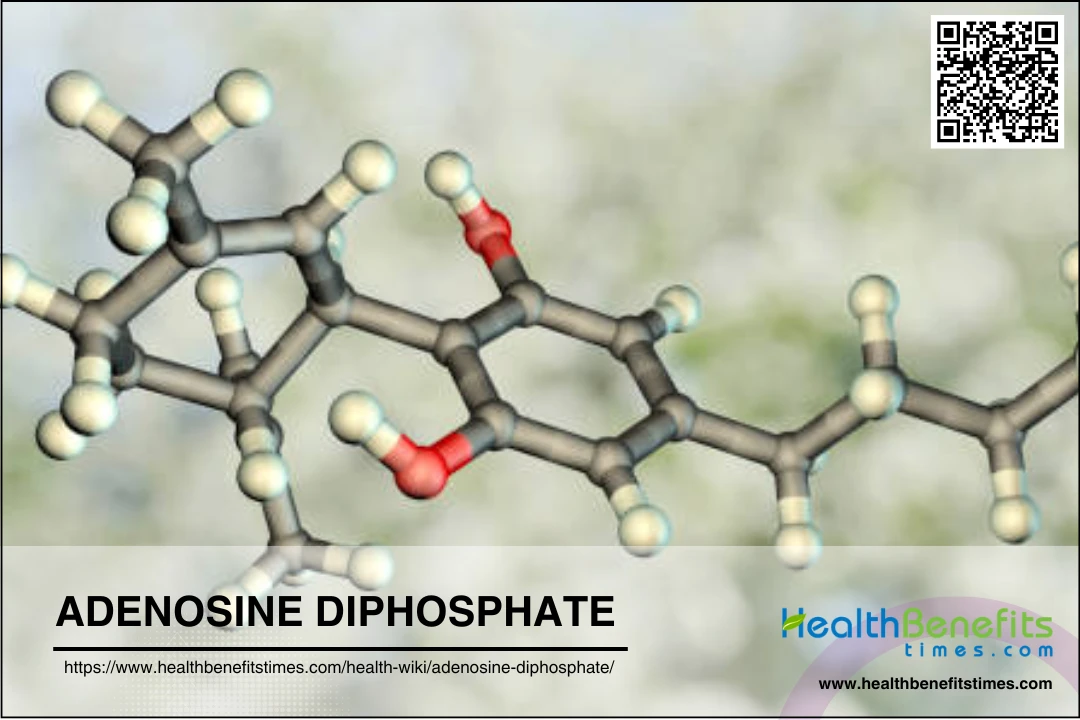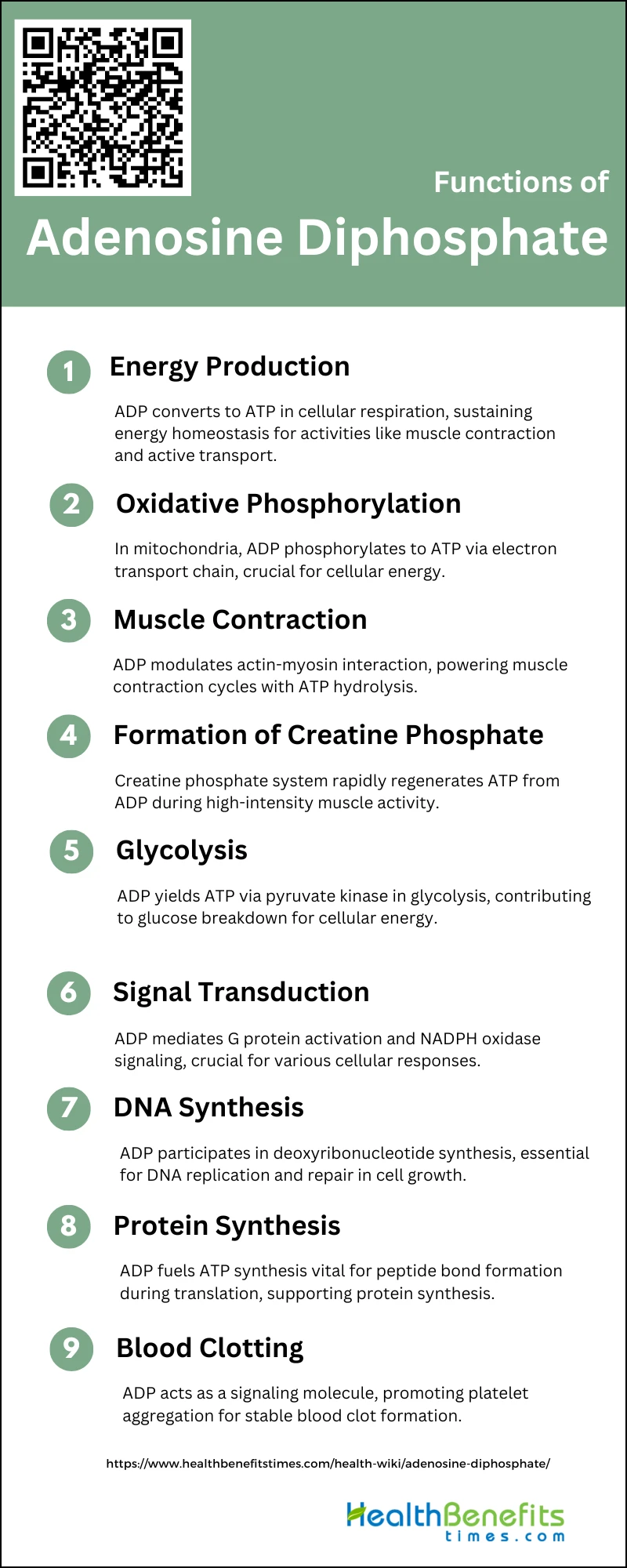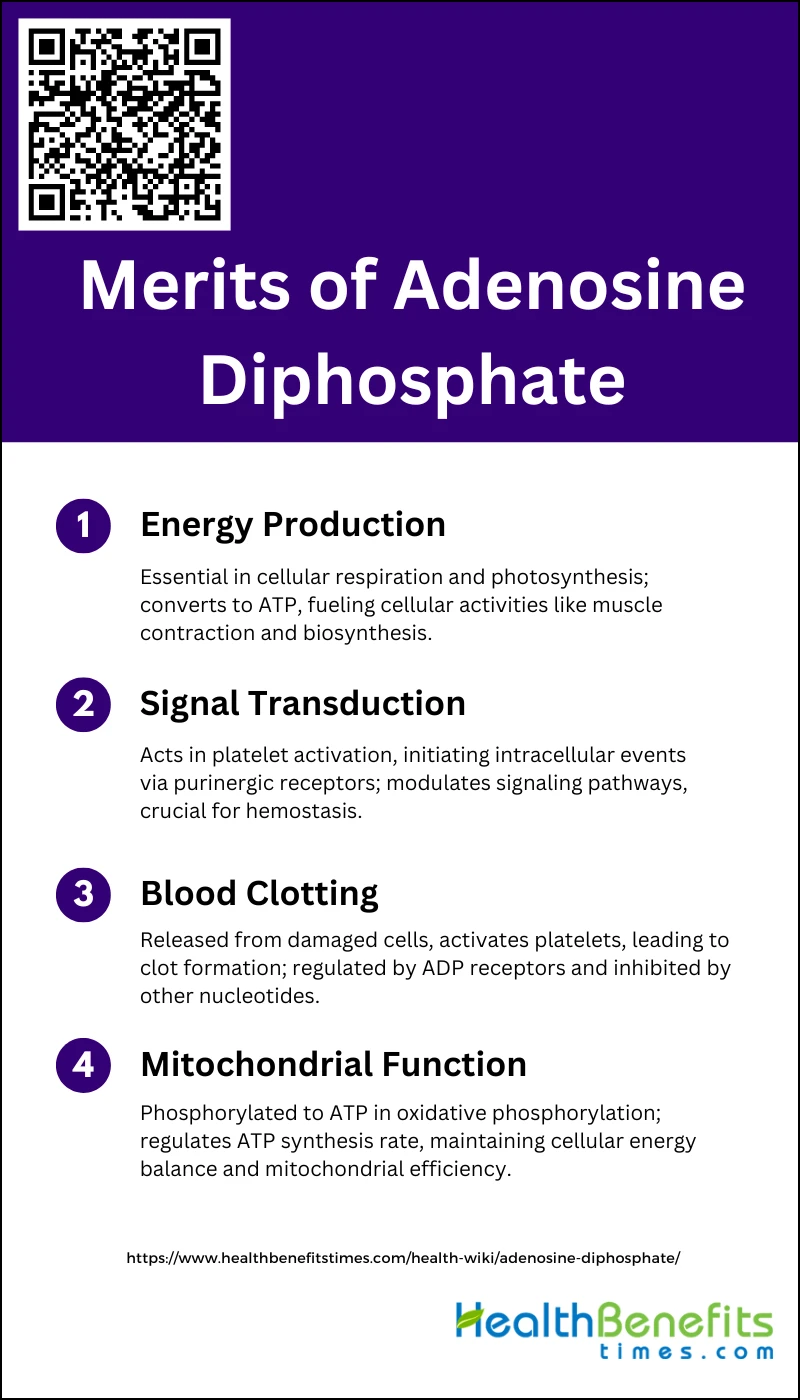 Adenosine diphosphate (ADP) is a crucial organic compound involved in energy transfer and metabolism in living cells. It consists of an adenine nucleobase, a ribose sugar, and two phosphate groups. ADP plays a central role in the ATP/ADP cycle, where it is interconverted with adenosine triphosphate (ATP) through the addition or removal of a phosphate group. When ATP is dephosphorylated by enzymes called ATPases, it releases energy that powers various cellular processes and produces ADP as a byproduct. Conversely, ADP can be rephosphorylated to regenerate ATP through processes like oxidative phosphorylation, photophosphorylation, and substrate-level phosphorylation, allowing the continuous flow of energy in cells.
Adenosine diphosphate (ADP) is a crucial organic compound involved in energy transfer and metabolism in living cells. It consists of an adenine nucleobase, a ribose sugar, and two phosphate groups. ADP plays a central role in the ATP/ADP cycle, where it is interconverted with adenosine triphosphate (ATP) through the addition or removal of a phosphate group. When ATP is dephosphorylated by enzymes called ATPases, it releases energy that powers various cellular processes and produces ADP as a byproduct. Conversely, ADP can be rephosphorylated to regenerate ATP through processes like oxidative phosphorylation, photophosphorylation, and substrate-level phosphorylation, allowing the continuous flow of energy in cells.
Importance of Adenosine Diphosphate
ADP is a molecule in many biochemical processes. It acts as a regulator and participant in cellular energy management. In Escherichia coli, ADP inhibits phosphoribosyl pyrophosphate synthase, which helps conserve ATP when energy levels are low. ADP can also be converted to ATP in spinach chloroplast thylakoids, showing its role in energy conversion and storage. In rabbit skeletal muscle, ADP affects phosphorylase kinase, influencing enzyme activity and conformation, which is important for muscle metabolism. ADP analogues have been studied for their inhibitory effects on polynucleotide phosphorylase, highlighting ADP’s regulatory potential in nucleotide metabolism. Lastly, ADP is involved in ATP synthesis in mungbean seeds, demonstrating its pivotal role in plant energy metabolism. These various functions emphasize the importance of ADP in maintaining cellular energy balance and regulating metabolic pathways.
Chemical Structure of Adenosine Diphosphate
It is a nucleotide made up of an adenine base, a ribose sugar, and two phosphate groups connected by strong bonds. The shape of the ADP molecule is usually folded, with the ribose ring having a specific puckering pattern and the glycosidic bond in a particular arrangement. The pyrophosphate chain of ADP has a unique geometry when viewed from a certain angle, different from other pyrophosphates. In the presence of metal ions like potassium, ADP can exist as a zwitterion, with the adenine base protonated at N(1) and the pyrophosphate group carrying a negative charge. Metal ions like Cu(II), Cd(II), or Hg(II) can form molecular complexes with ADP and polyamines, where the metal ions interact with specific parts of the nucleotide. These structural characteristics and interactions play a vital role in the biological functions of ADP, including its involvement in energy transfer and cell signaling.
Functions of Adenosine Diphosphate
As an energy currency, ADP is involved in numerous cellular functions, making it an indispensable component for life. The primary functions of ADP can be summarized as follows:
1. Energy Production
Adenosine diphosphate (ADP) plays a crucial role in energy production within cells. It is a key intermediate in the conversion of energy from nutrients into adenosine triphosphate (ATP), the primary energy currency of the cell. During cellular respiration, ADP is phosphorylated to ATP in processes such as glycolysis and oxidative phosphorylation. This conversion is essential for maintaining cellular energy homeostasis and supporting various biological activities, including muscle contraction and active transport.
2. Oxidative Phosphorylation
In oxidative phosphorylation, ADP is phosphorylated to ATP in the mitochondria. This process involves the electron transport chain and chemiosmosis, where the energy from electrons transferred through the chain is used to pump protons across the mitochondrial membrane, creating a proton gradient. The flow of protons back into the mitochondrial matrix through ATP synthase drives the phosphorylation of ADP to ATP, thus providing energy for cellular functions.
3. Muscle Contraction
It is involved in muscle contraction by modulating the interaction between actin and myosin, the primary proteins responsible for muscle contraction. During muscle contraction, ATP is hydrolyzed to ADP and inorganic phosphate, providing the energy required for the myosin heads to bind to actin filaments and perform the power stroke. ADP remains bound to myosin until a new ATP molecule binds, allowing the cycle to repeat and sustain muscle contraction.
4. Formation of Creatine Phosphate
ADP is regenerated to ATP through the creatine phosphate system, which acts as a rapid energy buffer in muscle cells. Creatine kinase catalyzes the transfer of a phosphate group from creatine phosphate to ADP, forming ATP and creatine. This reaction is crucial during short bursts of high-intensity activity, providing a quick supply of ATP to sustain muscle contraction and other cellular processes.
5. Glycolysis
In glycolysis, ADP is a substrate for the enzyme pyruvate kinase, which catalyzes the transfer of a phosphate group from phosphoenolpyruvate to ADP, forming ATP and pyruvate. This step is one of the key energy-yielding reactions in glycolysis, contributing to the net production of ATP from the breakdown of glucose. The generated ATP is then used to fuel various cellular activities.
6. Signal Transduction
Nucleoside-diphosphate kinase catalyzes the transfer of phosphate groups between nucleotides, including the conversion of GDP to GTP, which is essential for G protein activation. Activated G proteins can then stimulate various downstream signaling pathways, including those involved in the production of reactive oxygen species by NADPH oxidase.
7. DNA Synthesis
Ribonucleotide reductase catalyzes the reduction of ribonucleoside diphosphates, such as ADP, to their corresponding deoxyribonucleotides, which are then used for DNA replication and repair. This process is crucial for maintaining the integrity of the genetic material and supporting cell division and growth.
8. Protein Synthesis
The synthesis of proteins requires significant amounts of ATP, which is generated from ADP through cellular respiration and other metabolic pathways. ATP provides the energy needed for the formation of peptide bonds during translation, as well as for the activation of amino acids and the assembly of ribosomes.
9. Blood Clotting
ADP plays a role in blood clotting by acting as a signaling molecule that promotes platelet aggregation. When blood vessels are injured, platelets release ADP, which binds to specific receptors on the surface of other platelets, activating them and promoting their aggregation. This process is essential for the formation of a stable blood clot, which prevents excessive bleeding and facilitates wound healing.
Components of Adenosine diphosphate
Below is a list of the fundamental constituents that make up Adenosine diphosphate:
1. Adenosine
Adenosine is a nucleoside composed of an adenine molecule attached to a ribose sugar molecule. It plays a crucial role in various biochemical processes, including energy transfer as part of adenosine triphosphate (ATP) and adenosine diphosphate (ADP). In the context of ADP, adenosine forms the backbone to which phosphate groups are attached. The structure of adenosine is integral to the function of ADP, as it allows for the attachment of phosphate groups and the subsequent release of energy during hydrolysis. Studies have shown that adenosine is involved in the formation of complex molecules such as poly(adenosine diphosphate ribose), which is important in DNA repair and cellular signaling.
2. Two Phosphate Groups
Adenosine diphosphate (ADP) contains two phosphate groups attached to the ribose sugar of adenosine. These phosphate groups are linked by high-energy bonds, which are crucial for the molecule’s role in energy transfer within cells. The addition and removal of these phosphate groups are central to the molecule’s function in cellular metabolism. For instance, the conversion of ADP to ATP involves the addition of a third phosphate group, storing energy that can be released when ATP is hydrolyzed back to ADP. This process is fundamental to cellular activities such as muscle contraction, protein synthesis, and cell division.
3. Ribose
Ribose is a five-carbon sugar that forms the sugar backbone of adenosine diphosphate (ADP). In ADP ribose is connected to adenine at one end and to two phosphate groups at the other. The ribose sugar is crucial for the structural integrity and function of ADP, as it facilitates the attachment of the adenine base and the phosphate groups. Ribose’s role extends beyond ADP, as it is also a component of other nucleotides and nucleic acids, including RNA. The synthesis and modification of ribose-containing molecules are essential for various biological processes, including energy metabolism and genetic information transfer.
Merits of Adenosine Diphosphate
It serves as a fundamental energy currency within cells, facilitating numerous physiological processes. Below, we explore the various merits of ADP in cellular functions.
1. Energy Production
It is a key component in the process of cellular respiration and photosynthesis, where it is converted to adenosine triphosphate (ATP) through phosphorylation. This conversion is essential for storing and transferring energy within cells. The breakdown of ATP back to ADP releases energy that is used for various cellular activities, including muscle contraction, active transport, and biosynthesis of macromolecules. The dynamic inter-conversion between ADP and ATP is fundamental to maintaining the energy balance and metabolic functions of cells.
2. Signal Transduction
It acts as a signaling molecule by binding to purinergic receptors on the surface of cells, such as P2Y1 and P2Y12 receptors on platelets. This binding initiates a cascade of intracellular events that lead to platelet shape change, granule release, and aggregation, which are critical for hemostasis and thrombosis. The role of ADP in signal transduction is further highlighted by its ability to modulate other signaling pathways, such as those involving phosphoinositide 3-kinase (PI 3-kinase), which are essential for irreversible platelet aggregation.
3. Blood Clotting
It is released from damaged cells and activated platelets, contributing to the recruitment and activation of additional platelets at the site of injury. This leads to the formation of a platelet plug, which is the initial step in the formation of a stable blood clot. ADP-induced platelet aggregation is a well-documented phenomenon, and its effectiveness is influenced by the presence of calcium ions and plasma factors. The aggregation process is regulated by the interaction of ADP with its receptors and can be inhibited by other nucleotides such as ATP and adenosine.
4. Mitochondrial Function
Within the mitochondria, ADP is phosphorylated to ATP by the enzyme ATP synthase, which is driven by the proton gradient generated by the electron transport chain. This process is essential for the production of ATP, which serves as the primary energy currency of the cell. The availability of ADP is a limiting factor for ATP synthesis, and its concentration within the mitochondria regulates the rate of oxidative phosphorylation. Thus, ADP is crucial for maintaining mitochondrial efficiency and overall cellular energy homeostasis.
Demerits of Adenosine Diphosphate
One of the main demerits of ADP is its involvement in blood platelet activation. When ADP is released from activated platelets, it interacts with specific receptors on other platelets, leading to further platelet aggregation and clot formation. This process is essential for hemostasis but can also contribute to the development of thrombotic disorders, such as heart attacks and strokes, if excessive clotting occurs. Additionally, the conversion of ADP to adenosine by ecto-ADPases can inhibit platelet activation, which may increase the risk of bleeding in some cases.



